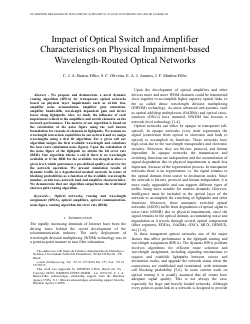
Impact of Optical Switch and Amplifier Characteristics on Physical Impairment-based Wavelength -Routed Optical Networks
C. Bastos Filho, S. C. Oliveira, E. A. J. Arantes, J. F. Martins Filho
DOI: 10.14209/sbrt.2003.126
Evento: XX Simpósio Brasileiro de Telecomunicações (SBrT2003)
Keywords: Optical networks routing and wavelength assignment (RWA) optical amplifiers optical communication noise figure routing algorithm bit error rate (BER)
Abstract
We propose and demonstrate a novel dynamic routing algorithm (RWA) for transparent optical networks based on physical layer impairments such as switch loss, amplifier noise accumulation, amplifier gain saturation, amplifier bandwidth, wavelength dependent gain and device losses along lightpaths. Also, we study the influence of each impairment related to the amplifiers and switch elements, on the network performance. The metrics of our algorithm is based on the calculation of the noise figure using the well known formulation for cascade of elements in lightpaths. We assume no wavelength conversion capabilities in our network and we assign wavelengths using a first fit algorithm. For a given call our algorithm assigns the first available wavelength and calculates the best route (minimum noise figure). Upon the calculation of the noise figure of the lightpath we obtain the bit error rate (BER). Our algorithm blocks a call if there is no wavelength available or if the BER for the available wavelength is above a given level, which guarantees a pre-defined quality-of-service for the network operation. We present simulation results of dynamic traffic in a hypothetical meshed network in terms of blocking probabilities as a function of the available wavelengths number, switch loss, network load and amplifier characteristics. We demonstrate that our algorithm outperforms the traditional shortest path routing algorithm.Download